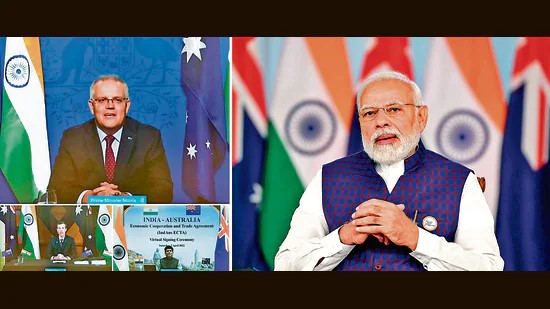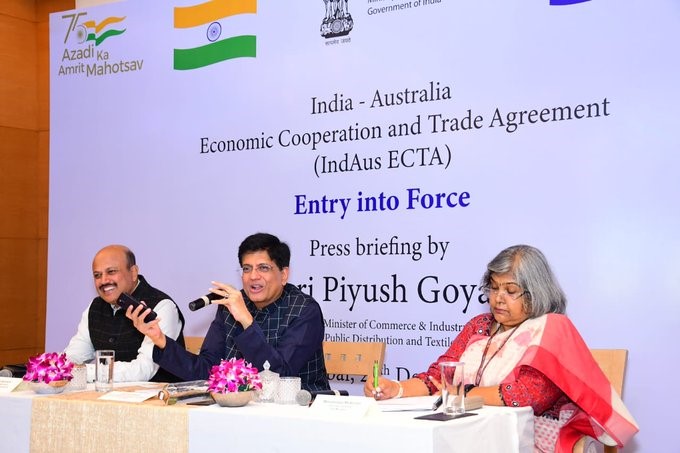Did you know that India and Australia have entered into an Economic Cooperation and Trade Agreement? Yes, the #IndAusECTA was signed last year, on 2nd April, 2022; after Ratification and Exchange of Written Instruments, the Agreement has come into force on 29th December 2022.
A Win-Win for both India and Australia
It helps matters that Australia exports largely raw materials to India, while India exports finished goods. The ECTA builds on this complementarity, creating win-win opportunities for the two countries. Here is what Additional Secretary, Department of Commerce and Industry, Rajesh Agrawal says: “The Department of Commerce has achieved the unique distinction of operationalizing two Trade Agreements this year - India UAE FTA and Ind – Aus ECTA. The coming into force of Ind – Aus ECTA brings together two major economies of the world - India the 5th largest economy and Australia the 14th largest economy. Since the trade between the two countries is hugely complementary, this offers opportunities on both sides and will pave the way for a win-win solution for both India and Australia.”
So, what are these complementarities? Before we explore that, let us look at the current position of trade between the two countries, the before-position so to say, to understand how the picture will change in wake of the agreement.
Current trade trends between India and Australia
India’s imports from Australia amount to 17 US $ billion while its exports to Australia amount to 10.5 US $ billion. However, what we need to realize that India’s imports from Australia are primarily (96%) raw materials & intermediate goods. They are highly concentrated in Coal (74% of Australia’s exports to India) out of which 71.4% is coking coal. On the other hand, India’s exports to Australia are broad-based and dominated by finished products (consumer goods). India also spends $ 4 bn approx. each year on education of students in Australia.
The above composition of our bilateral trade is very well reflected in the statements made by the Union Commerce and Industry Minister Piyush Goyal, during the event held in Mumbai on December 29, 2022, the day the agreement came into force.
“There is a lot of potential for exporting finished goods to Australia, since they hardly manufacture anything, they are largely a raw material and intermediate producing country, we will get cheaper raw materials which will not only make us more competitive globally but also enable us to serve Indian consumers better; enabling us to provide more quality goods at more affordable prices.”
“Australia, which is largely dependent on imports, will benefit hugely, they will soon start seeing a lot more finished goods coming in from India, providing huge amount of work and job opportunities in both goods and services, provided by Indian talent.”
The #IndAusECTA covers the following major areas:
 Addressing the media briefing to mark the coming into force of the #IndAusECTA, Union Minister for Commerce and Industry Piyush Goyal said that the ECTA has been negotiated with the speed of Brett Lee and the perfection of Sachin Tendulkar and is a labour of love between the two countries. The Minister further assured that the Indian government will continue to negotiate for a bright future for the people of the country, for innovation, education, health and technology.
Watch the media briefing by the Minister, in full here.
Addressing the media briefing to mark the coming into force of the #IndAusECTA, Union Minister for Commerce and Industry Piyush Goyal said that the ECTA has been negotiated with the speed of Brett Lee and the perfection of Sachin Tendulkar and is a labour of love between the two countries. The Minister further assured that the Indian government will continue to negotiate for a bright future for the people of the country, for innovation, education, health and technology.
Watch the media briefing by the Minister, in full here.
 Writing about the Agreement, Senator the HON Don Farrel, Minister of Trade and Tourism, Australian Government has said that India’s youthful population, diversified economy and growth trajectory present significant opportunities for Australian businesses, including in education, agriculture, energy, resources, tourism, healthcare, financial services, infrastructure, science and innovation and sport. Read the Minister’s article in full here.
All the necessary notifications required for entry into force of Ind-Aus ECTA on 29.12.2022 have been issued by Department of Revenue and the Directorate General of Foreign Trade in the Department of Commerce.
More information on procedural issues and queries regarding the India Australia ECTA can be found below:
Writing about the Agreement, Senator the HON Don Farrel, Minister of Trade and Tourism, Australian Government has said that India’s youthful population, diversified economy and growth trajectory present significant opportunities for Australian businesses, including in education, agriculture, energy, resources, tourism, healthcare, financial services, infrastructure, science and innovation and sport. Read the Minister’s article in full here.
All the necessary notifications required for entry into force of Ind-Aus ECTA on 29.12.2022 have been issued by Department of Revenue and the Directorate General of Foreign Trade in the Department of Commerce.
More information on procedural issues and queries regarding the India Australia ECTA can be found below:
- Trade in Goods
- Trade in Services
- Rules of Origin
- Technical Barriers to Trade (TBT) and Sanitary and Phytosanitary (SPS) measures
- Customs Procedures and Trade Facilitation
- Trade Remedies
- Legal & institutional Issues
- Movement of Natural Persons
- The following protective features have been put into place keeping in mind any concern on leakage / diversion of products made in a third country, to India through Australia.
- Stringent Rules of Origin – Value Addition of 35% + Change in Tariff Subheading (CTSH)
- In calculation of Value Addition, 2 different values agreed to (35% or 45%) depending on method of calculation (based on whether profit is excluded or included)
- Product Specific Rules negotiated for 807 products
- Requirement of ‘melt and pour’ for iron & steel products included in the Product Specific Rules for these products.
- Strict Operational Customs Procedures
- A specific clause included to ensure only items made in Australia count for value addition, no other country products
- A Bilateral Safeguard Mechanism will be available for 14 years in case of surge in imports
- A special clause on Review has been agreed upon to enable either country to request a Review for parts of the Agreement which may be a cause of concern, after 15 years
- Review compulsory if requested (it shall happen)
- Must be completed in 6 months
- India has not provided access and kept out milk and other dairy products, wheat, sugar, iron ore, apple and walnuts from its offers to Australia. This is normally impossible as these are the major exports of Australia.
- Australia hopes for gains for its products such as Coal and Wines plus a few quotas in agriculture / horticulture products (almonds, cotton, lentil, pears, oranges, etc.) which are already being imported.
- Australia has offered Zero duty access to 100% of its lines & trade whereas India has so far offered only 70% of its lines for duty free/ reduced duty access to Australia.
- India can benefit hugely in the pharmaceutical sector. Through the Agreement, drugs approved in other developed jurisdictions will get quicker approval in Australia. This will enable easy penetration of the Australian medical market (India is just 3%).
- Major gains are expected for India’s labour-intensive sectors such as textiles/ apparel, leather/ footwear, gems and jewellery, fish products, machinery and electrical goods. They will gain duty free access on par with Vietnam and other countries, making them competitive.
- Liberal grant of work visas to students, employee/ worker visas, agriculture worker visas.
- This agreement hopes to encourage other developed countries such as UK, Canada, Europe to sign similar agreements with India.
- The Agreement allows India to overcome any loss it would have incurred as a result of walking out of RCEP, which was virtually an FTA with China.
 Addressing the media briefing to mark the coming into force of the #IndAusECTA, Union Minister for Commerce and Industry Piyush Goyal said that the ECTA has been negotiated with the speed of Brett Lee and the perfection of Sachin Tendulkar and is a labour of love between the two countries. The Minister further assured that the Indian government will continue to negotiate for a bright future for the people of the country, for innovation, education, health and technology.
Watch the media briefing by the Minister, in full here.
Addressing the media briefing to mark the coming into force of the #IndAusECTA, Union Minister for Commerce and Industry Piyush Goyal said that the ECTA has been negotiated with the speed of Brett Lee and the perfection of Sachin Tendulkar and is a labour of love between the two countries. The Minister further assured that the Indian government will continue to negotiate for a bright future for the people of the country, for innovation, education, health and technology.
Watch the media briefing by the Minister, in full here.
 Writing about the Agreement, Senator the HON Don Farrel, Minister of Trade and Tourism, Australian Government has said that India’s youthful population, diversified economy and growth trajectory present significant opportunities for Australian businesses, including in education, agriculture, energy, resources, tourism, healthcare, financial services, infrastructure, science and innovation and sport. Read the Minister’s article in full here.
All the necessary notifications required for entry into force of Ind-Aus ECTA on 29.12.2022 have been issued by Department of Revenue and the Directorate General of Foreign Trade in the Department of Commerce.
More information on procedural issues and queries regarding the India Australia ECTA can be found below:
Writing about the Agreement, Senator the HON Don Farrel, Minister of Trade and Tourism, Australian Government has said that India’s youthful population, diversified economy and growth trajectory present significant opportunities for Australian businesses, including in education, agriculture, energy, resources, tourism, healthcare, financial services, infrastructure, science and innovation and sport. Read the Minister’s article in full here.
All the necessary notifications required for entry into force of Ind-Aus ECTA on 29.12.2022 have been issued by Department of Revenue and the Directorate General of Foreign Trade in the Department of Commerce.
More information on procedural issues and queries regarding the India Australia ECTA can be found below:
- Customs Notifications:
- On Tariff concessions (Customs Tariff Notification)
- On Rules of Origin (No. 112/2022-Customs (N.T.)
- DGFT Notifications & Public Notices:
- List of Agencies for Certificate of Origin (Public Notice No: 44/2015-20; Dated 22.12.2022)
- Trade Notice on Electronic filing & Issuance of Preferential certificate of Origin (Trade Notice No. 23/2022-23; 22.12.2022)
- TRQ allocation (Public Notice)
- DGFT Helpdesk for Common Digital platform for issuance of Certificate of Origin:
- Tel No.:1800-111-550
- Email: coo-dgft[at]gov[dot]in.
- Weblink for online CoO: coo.dgft.gov.in






















